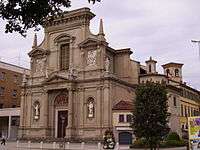Santi Bartolomeo e Stefano, Bergamo
| Santi Bartolomeo e Stefano | |
|---|---|
 | |
| Basic information | |
| Location | Bergamo, Italy |
| Geographic coordinates | Coordinates: 45°41′45″N 9°40′18″E / 45.69583°N 9.67153°E |
| Affiliation | Roman Catholic |
| Architectural description | |
| Architect(s) | Anton Maria Caneva |
| Architectural type | Church |
| Architectural style | Renaissance |
| Groundbreaking | 1642 |
| Specifications | |
| Direction of façade | 1613 |
| Length | 60 meters |
| Width | 14 meters |

Santi Bartolomeo e Stefano is an Baroque-style, Roman Catholic church located on Largo Belotti #1 in Bergamo, region of Lombardy, Italy. The church is associated with a Dominican convent; and stands about a block away from the Teatro Donizetti.
History
The church was built in 1613-1642, adjacent to a monastery of San Bartolomeo, which had belonge to the religious order of the Humiliati. After this order was suppressed, this convent was granted to the Dominicans, with whom it remains associated today. The monastery had been destroyed and rebuilt in 1970 by the Dominicans.
The church houses a large canvas, a masterpiece by the well-known painter Lorenzo Lotto called Pala Martinengo, or Martinengo Altarpiece.
The chapel of the Madonna of the Rosary is highly decorated in stucco and painting (1752) by the studio of Antonio and Muzio Camuzio . The Bolognese painter Francesco Monti decorated the area of the cupola with a transfiguration. The cornices are decorated with 15 Holy Mysteries of the Rosary (1757) in monochrome by Giuseppe Antonio Felice Orelli. The chorus was carved by Damiano Zambelli (1480 - 1549) for the church of San Stefano, which was torn down, and thus the choir stalls moved ultimately to end here. The ceiling of the nave was frescoed by Mattia Bortoloni. He also frescoed (1749) in the choir and presbytery, the Sacrifice of Isaac and Glory of Santissimi Sacramento, but died prior to completion of all his designs. Further frescoes in the ceiings including a Glory of the Dominican Order (1751) were completed by Gaspare Diziani.
Other Altarpieces include paintings by Mauro Picenardi, Giuseppe Brena, Enea Salmeggia also called il Talpino, Francesco Coppella, Pietro Ricchi also called il Lucchese, Carlo Salis, Giovanni Battista Discepoli also called lo Zoppo, Agostino Facheris also called il Caversegno, Pietro Damiani da Castelfranco, and Giorgio Anselmi